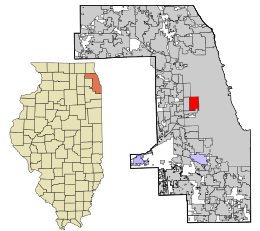Cicero, Illinois
| Cicero, Illinois | |
|---|---|
| Town | |

The last vestige of the Hawthorne Works, which at its peak in the early 20th century employed over 40,000 workers
|
|
 Location in Cook County and the state of Illinois. |
|
 Location of Illinois in the United States |
|
| Coordinates: 41°50′40″N 87°45′33″W / 41.84444°N 87.75917°WCoordinates: 41°50′40″N 87°45′33″W / 41.84444°N 87.75917°W | |
| Country |
|
| State | Illinois |
| County | Cook |
| Township | Cicero |
| Incorporated | February 28, 1867 |
| Government | |
| • Type | Council-manager |
| • President | Larry Dominick |
| Area | |
| • Total | 5.87 sq mi (15.2 km2) |
| • Land | 5.87 sq mi (15.2 km2) |
| • Water | 0.00 sq mi (0.0 km2) 0% |
| Elevation | 607 ft (185 m) |
| Population (2013) | |
| • Total | 84,103 |
| • Density | 14,303.7/sq mi (5,522.7/km2) |
| Up 0.3% from 2010 | |
| Standard of living (2011) | |
| • Per capita income | $14,539 |
| • Median home value | $157,500 |
| ZIP code(s) | 60804 |
| Area code(s) | 708 |
| Geocode | 17-14351 |
| Website | www |
Cicero, a suburb of Chicago, is an incorporated town in Cook County, Illinois, United States. The population was 83,891 at the 2010 census. As of 2013, the town had a total population of 84,103, making it the tenth-largest municipality in Illinois. Cicero is named for the town of Cicero, New York, which in turn was named for Marcus Tullius Cicero, the Roman statesman and orator.
Originally, Cicero Township occupied six times its current territory. Weak political leadership and town services resulted in cities such as Oak Park and Berwyn voting to split off from Cicero, and other portions such as Austin were annexed into the city of Chicago.
Al Capone built his criminal empire in Chicago before moving to Cicero to escape the reach of Chicago police.
On July 11–12, 1951, a race riot erupted in Cicero when a mob of around 4,000 attacked and burned an apartment building at 6139 W. 19th Street that housed the African-American family of Harvey Clark Jr., a Chicago Transit Authority bus driver who had relocated to the then-all-white city. Governor Adlai E. Stevenson was forced to call out the Illinois National Guard. The Clarks moved away, and the building had to be boarded up. The Cicero riot received worldwide condemnation.
The 1980s and 1990s saw a heavy influx of Hispanic (mostly Mexican and Central American) residents to Cicero. Once considered mainly a Czech or Bohemian town on 22nd Street (now Cermak Road), most of the European-style restaurants and shops have been replaced by Spanish-titled businesses. In addition, Cicero has a small black community.
...
Wikipedia
